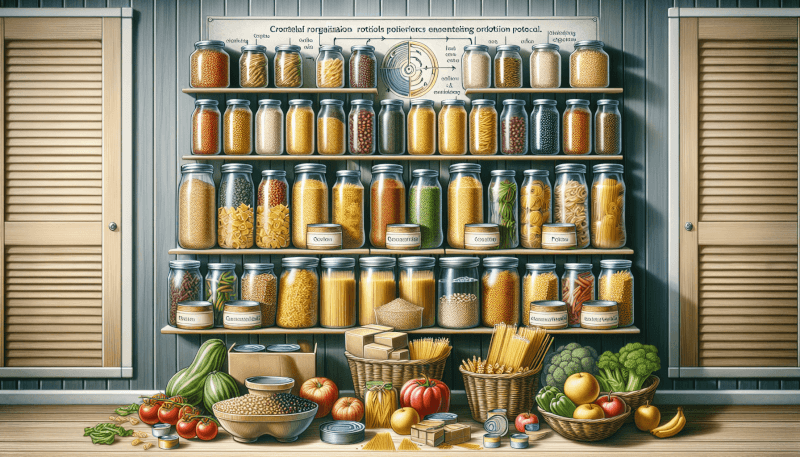In this article, you will discover the key to maintaining an efficient and organized food storage inventory. We will explore the best practices that will not only save you time and money but also ensure that your stock is always fresh and ready to use. By following these simple guidelines, you can avoid spoilage, reduce waste, and always have the right ingredients on hand for all your culinary adventures. So, get ready to revolutionize the way you manage your food storage and enjoy a well-stocked pantry that will impress even the most discerning cooks.

1. Understand the Importance of Rotating Food Storage Inventory
Rotating food storage inventory is crucial for several reasons. Firstly, it helps minimize food waste. When you have a system in place for rotating your food, you can ensure that older items are used before they expire, reducing the chances of them going to waste.
Secondly, rotating your food storage ensures freshness and quality. By consistently using the first-in, first-out (FIFO) method, you can ensure that your customers or family members are always getting the freshest products. This is especially important for items like dairy, produce, and meats, which can spoil quickly if not used in a timely manner.
Lastly, rotating your food storage helps prevent spoilage and contamination. By paying attention to expiration dates and regularly checking the condition of your stored items, you can identify and remove any spoiled or contaminated products before they have a chance to affect the rest of your inventory.
2. Create a System for Organizing Food Storage
To effectively rotate your food storage inventory, it is essential to have a well-organized system in place. By following these steps, you can establish an efficient and easily manageable storage system:
Categorize and Label Food Items
Start by categorizing your food items based on their type, such as dry goods, canned goods, perishables, etc. This will make it easier to locate specific items when needed. Additionally, labeling containers or shelves with the type of food and the date of storage will help you keep track of the oldest items.
Establish First-In, First-Out (FIFO) System
Implement a first-in, first-out system to ensure that older items are used before newer ones. This means that when you stock new items, place them behind the older items so that the older ones are used first. This practice will help prevent any items from being forgotten and expiring before they can be used.
Use Clear Containers or Storage Bags
Using clear containers or storage bags allows you to easily see the contents without having to open every container. This way, you can quickly identify which items need to be used first and maintain proper rotation.
3. Track Expiration Dates
Tracking expiration dates is vital to ensuring the safety and quality of your stored food. Follow these steps to effectively track expiration dates:
Regularly Check Expiration Dates
Make it a habit to regularly check the expiration dates of all stored items. This can be done during inventory checks, preferably weekly or before restocking. Remove any items that are close to or past their expiration dates to prevent spoilage or risk of contamination.
Implement a Schedule for Rotation
Establish a rotation schedule based on the expiration dates of your food items. Prioritize using items that are closest to expiration to avoid any wastage. Create a system that allows you to easily identify which items need to be used first.
Use Software or Apps for Tracking
Consider using software or apps specifically designed for tracking food expiration dates. These tools can help you keep a digital record of your inventory, send alerts when items are nearing expiration, and streamline the process of rotating your food storage.
4. Identify Shelf Life of Different Foods
Understanding the shelf life of different food items is essential for effective rotation. Follow these steps to gain a better understanding:
Understand Shelf Life Guidelines
Consult reliable sources, such as food safety websites or guidelines from regulatory agencies, to understand the general shelf life of different types of food. Familiarize yourself with the recommended storage conditions and expiration timeframes for each category of food.
Consider Factors Affecting Shelf Life
It’s important to consider external factors that can impact the shelf life of your stored food. Factors like temperature, humidity, exposure to light, and the packaging materials used can all affect how long a food item remains fresh. Take these factors into account while storing your food.
Create a Chart or Reference Guide
Create a chart or reference guide that lists the shelf life of different food items in your inventory. This will serve as a quick and easy resource for you and your staff to reference when determining which items need to be used first.

5. Implement Regular Inventory Checks
Regularly conducting inventory checks is a crucial part of ensuring proper food storage rotation. Follow these steps to establish a routine:
Establish a Frequency for Inventory Checks
Set a frequency for conducting inventory checks that suits the needs of your establishment or household. This could be weekly, bi-weekly, or monthly, depending on the volume of food being stored. Consistency is key to maintaining an accurate inventory and identifying any potential issues promptly.
Conduct Thorough Inspections
During inventory checks, thoroughly inspect each item for signs of spoilage, damage, or contamination. Look out for dented cans, signs of pests or rodents, foul odors, or any visible mold. Remove any items that do not meet safety standards or appear to be compromised.
Record and Monitor Inventory Levels
Keep a record of your inventory levels after each inventory check. This will not only help you keep track of your stock but also give you an idea of how quickly items are being used. If you notice certain items consistently going to waste, you may need to adjust your purchasing or storage habits to prevent future waste.
6. Train Staff on Rotating Food Storage Practices
If you have a team working with you in your food storage facility or kitchen, it is crucial to provide them with proper training on rotational practices. Here’s what you can do:
Provide Training on Rotating Techniques
Educate your staff on the importance of rotating food storage inventory and train them on the specific techniques required to implement an effective rotation system. Make sure they understand the first-in, first-out concept and how to identify and handle expired or spoiled items.
Educate Staff on Storage Guidelines
In addition to rotation techniques, educate your staff on proper storage guidelines for different types of food items. Teach them about the appropriate temperature ranges, humidity levels, and packaging requirements for different categories of food to ensure maximum freshness and quality.
Ensure Consistent Practice and Understanding
Regularly reinforce the importance of rotating food storage to ensure consistent practice and understanding among your staff. Encourage open communication and address any questions or concerns they may have regarding the rotation process. Teamwork and a shared commitment to proper food storage will help maintain the integrity of your inventory.

7. Implement a First Aid Kit and Emergency Plan
In any food storage environment, it’s essential to be prepared for emergencies and have the necessary supplies readily available. Follow these steps to ensure preparedness:
Ensure First Aid Supplies are Available
Keep a well-stocked first aid kit in your storage area or kitchen. Ensure that it contains all the necessary supplies to address minor injuries or accidents. Regularly check the kit and restock any items that have been used or are nearing expiration.
Establish Emergency Response Procedures
Create and communicate clear emergency response procedures to your staff. This should include protocols for handling spills, accidents, power outages, or any other potential emergencies related to food storage. Ensure that everyone knows how to respond efficiently and safely in such situations.
Regularly Review and Update the Plan
Regularly review and update your emergency response plan to account for any changes in your storage facility or inventory. This will help ensure that your staff is always prepared to handle emergencies effectively. Conduct drills or simulations periodically to reinforce the plan’s effectiveness.
8. Consider Environmental Factors
The environmental conditions in your food storage area can greatly impact the quality and shelf life of your inventory. Consider the following factors:
Control Temperature and Humidity Levels
Maintain appropriate temperature and humidity levels in your storage area. Different types of food have different optimal storage conditions, so make sure you are aware of the recommended ranges. Use thermometers and humidity sensors to monitor and regulate the environment accordingly.
Store Food Away from Direct Sunlight
Direct sunlight can accelerate the degradation and spoilage of certain food items. Avoid placing your storage shelves or containers in areas that are exposed to direct sunlight. Instead, choose a location that is cool, dark, and free from any sources of heat.
Avoid Areas with Strong Odors or Chemicals
Keep your food storage area away from any strong odors or chemicals that can contaminate your inventory. Some foods are highly absorbent and can easily pick up odors, affecting their taste and quality. Store food away from cleaning supplies, chemicals, or any other items that may release strong odors.

9. Monitor and Adjust Inventory Based on Demand
To prevent overstocking or understocking, it’s important to monitor the demand for different food items. Follow these steps to effectively manage your inventory:
Track Sales and Consumption Patterns
Regularly track and analyze your sales and consumption patterns. Take note of which items are frequently purchased or consumed and which items tend to sit on the shelves longer. This will help you adjust your inventory levels accordingly and avoid wasting resources on items with low demand.
Avoid Overstocking or Understocking
Based on your sales and consumption patterns, adjust your ordering quantities to avoid overstocking or understocking. Overstocking can lead to increased waste, while understocking can lead to customer dissatisfaction. Strive to maintain a well-balanced inventory that meets the needs of your customers or household.
Adjust Inventory Levels Accordingly
As you track and analyze your sales and consumption patterns, be prepared to make adjustments to your inventory levels. Regularly review and update your stock levels based on demand, seasonality, and any other factors that may affect the quantity of food items needed.
10. Regularly Clean and Maintain Storage Areas
Maintaining a clean and pest-free storage area is crucial to ensuring food safety and preventing contamination. Follow these steps to keep your storage areas in optimal condition:
Establish Cleaning Schedules
Create a regular cleaning schedule for your storage areas. This should include cleaning shelves, containers, and any equipment used for storing food. Thoroughly clean surfaces, remove any spilled or spoiled items promptly, and sanitize the area regularly to prevent the growth of bacteria or pests.
Remove Spills or Contaminants Promptly
Address any spills or contaminants immediately to prevent cross-contamination or the spread of pests. Clean up any spills promptly using appropriate cleaning agents, and ensure that contaminated items are disposed of properly. Regularly inspect your storage areas for any signs of pests and take immediate action if necessary.
Inspect for Pests and Take Immediate Action
Regularly inspect your storage areas for signs of pests, such as gnaw marks, droppings, or damaged packaging. If you notice any signs of pests, take immediate action to eliminate them. Work with pest control professionals, if necessary, to implement effective pest management strategies and protect your stored food from contamination.
By following these best practices for rotating food storage inventory, you can minimize waste, ensure the freshness and quality of your food, and maintain a safe and well-organized storage environment. Implementing these practices and regularly reviewing and adjusting your inventory management strategies will help you streamline your operations and ensure the satisfaction of your customers or family members. Keep in mind that proper food storage and rotation not only benefit you but also contribute to food safety and a healthier environment overall.



